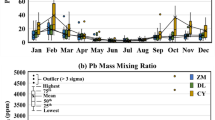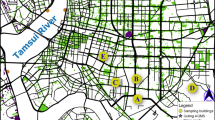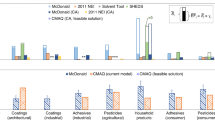Abstract
In an earlier paper based on PM2.5 speciation network data, we showed that nickel (Ni) concentrations were much higher in New York City (NYC) than in New Jersey (NJ) and Connecticut (CT), and that the NYC levels, but not those in NJ and CT, were much higher in the winter than in summer. However, all of the speciation sites in NYC were in the northern half of the city. To determine the distributions of Ni and other PM2.5 components within NYC, we collected 8-weeklong filter samples at 10 sites throughout NYC in both winter and summer, and measured the concentrations of the elements by X-ray fluorescence (XRF). The resulting data, together with speciation network site data, were used to construct seasonal average concentration isopleth maps for Ni and vanadium (V). As expected, Ni was much higher in Bronx than in Brooklyn, and much higher in winter than in summer. By contrast, V was higher in Brooklyn than in Bronx, and the winter and summer levels were similar. It appears that space-heating boilers are the major source category for Ni in NYC, whereas the Port of New York is the major source of V.
This is a preview of subscription content, access via your institution
Access options
Subscribe to this journal
Receive 6 print issues and online access
$259.00 per year
only $43.17 per issue
Buy this article
- Purchase on Springer Link
- Instant access to full article PDF
Prices may be subject to local taxes which are calculated during checkout






Similar content being viewed by others
References
Dominici F, McDermott A, Daniels M, Zeger S, and JM S (Health Effects Institute). Mortality among residents of 90 cities. Revised Analyses of Time-Series of Air Pollution and Health 2003, 9–24.
Dominici F, Peng RD, Ebisu K, Zeger SL, Samet JM, and Bell ML . Does the effect of Pm10 on mortality depend on Pm nickel and vanadium content? A reanalysis of the Nmmaps data. Environ Health Perspect 2007: 115 (12): 1701–1703.
EIA. Energy Information Administration, Sales of Fuel Oil and Kerosene 2007, Sales of Fuel Oil and Kerosene, No. DOE/EIA-0535(06) Government Printing Office: Washington, DC, 2007.
Franklin M, Koutrakis P, and Schwartz J . The role of particle composition on the association between Pm2.5 and mortality. Epidemiology 2008: 19 (5): 680–689.
Ito K, Xue N, and Thurston G . Spatial variation of Pm2.5 chemical species and source-apportioned mass concentrations in New York City. Atmos Environ 2004: 38 (31): 5269–5282.
Lippmann M, Gordon T, and Chen LC . Effects of subchronic exposures to concentrated ambient particles (caps) in mice: I. Introduction, objectives, and experimental plan. Inhal Toxicol 2005: 17 (4–5): 177–187.
Lippmann M, Ito K, Hwang JS, Maciejczyk P, and Chen LC . Cardiovascular effects of nickel in ambient air. Environ Health Perspect 2006: 114 (11): 1662–1669.
Maciejczyk P, and Chen LC . Effects of subchronic exposures to concentrated ambient particles (caps) in mice: Viii. Source-related daily variations in in Vitro responses to caps. Inhal Toxicol 2005: 17 (4–5): 243–253.
NYSERDA (New York State Energy and Research and Development Authority). Petroleum Infrastructure Study - Final Report 2006 eds: Wesley C., et al.(024176000104): 107.
Peltier RE, Hsu S-I, Lall R, and Lippmann M . Residual oil combustion: A major source of airborne nickel in New York City. J Expo Anal Environ Epidemiol 2008.
Schirmacher M, Freimann P, Schmidt D, and Dahlmann G . Trace-Metal determination by total-reflection X-Ray-fluorescence (Txrf) for the differentiation between pure fuel-oil (bunker oil) and waste oil (Sludge) in maritime shipping legal cases. Spectrochim Acta Part B At Spectrosc 1993: 48 (2): 199–205.
USEPA. Compilation of Air Pollutant Emission Factors. Volume 1. Stationary Point and Area Sources 1995 No. AP-42-ED-5 Research Triangle Park, NC.
Zanobetti A, Franklin M, and Schwartz J . Fine particulate air pollution and its components in association with cause-specific emergency admissions in 26 US cities. Epidemiology 2008: 16: S315–S316.
Acknowledgements
This research was supported, in part, by a post-doctoral training grant for Dr. Peltier from NIEHS (ES 007324), by a research grant from the Health Effects Institute, and utilized support services and a pilot project grant from NYU's NIEHS Center Grant (ES 00260). We also acknowledge the efforts of the volunteer NYU staff, students, and friends who assisted with these measurements at their residences.
Author information
Authors and Affiliations
Corresponding author
Rights and permissions
About this article
Cite this article
Peltier, R., Lippmann, M. Residual oil combustion: 2. Distributions of airborne nickel and vanadium within New York City. J Expo Sci Environ Epidemiol 20, 342–350 (2010). https://doi.org/10.1038/jes.2009.28
Received:
Accepted:
Published:
Issue Date:
DOI: https://doi.org/10.1038/jes.2009.28
Keywords
This article is cited by
-
Impacts of tropical cyclones and anthropogenic activities on marine vanadium: A unique perspective from high resolution Porites coral record
Science China Earth Sciences (2022)
-
Chemical composition and source attribution of PM2.5 and PM10 in Delhi-National Capital Region (NCR) of India: results from an extensive seasonal campaign
Journal of Atmospheric Chemistry (2021)
-
Indoor air pollution and respiratory health effects in inner city children with moderate to severe asthma
Air Quality, Atmosphere & Health (2020)
-
Metal-Induced Pulmonary Fibrosis
Current Environmental Health Reports (2018)
-
Short-term exposure to PM2.5 and vanadium and changes in asthma gene DNA methylation and lung function decrements among urban children
Respiratory Research (2017)



